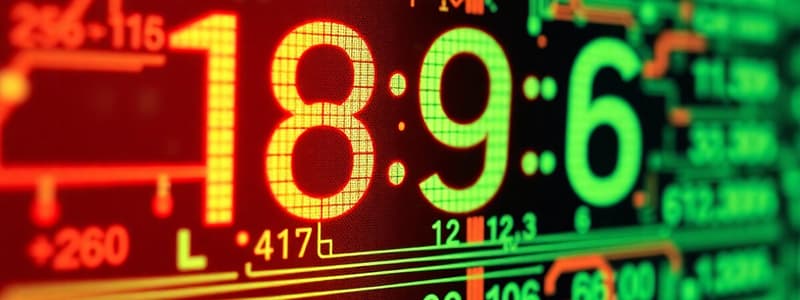Podcast
Questions and Answers
What is the base of the Binary Number System?
What is the base of the Binary Number System?
- 8
- 2 (correct)
- 16
- 10
Which of the following number systems uses sixteen unique symbols?
Which of the following number systems uses sixteen unique symbols?
- Decimal Number System
- Binary Number System
- Octal Number System
- Hexadecimal Number System (correct)
Which base does the Decimal Number System use?
Which base does the Decimal Number System use?
- 10 (correct)
- 2
- 8
- 4
In positional value, what does each position represent?
In positional value, what does each position represent?
Which number system relies on only two digits to perform operations?
Which number system relies on only two digits to perform operations?
Which of the following does the Octal Number System use?
Which of the following does the Octal Number System use?
What defines a number system's base or radix?
What defines a number system's base or radix?
Which application does not typically involve number systems in digital electronics?
Which application does not typically involve number systems in digital electronics?
Flashcards are hidden until you start studying
Study Notes
Number Systems in Digital Electronics
- Number systems represent information mathematically using specific bases or radices.
- Common number systems include decimal (base 10), binary (base 2), octal (base 8), and hexadecimal (base 16).
- The base of a number system indicates the total unique digits used, with digits ranging from 0 to (base - 1).
Definition and Importance
- A number system provides a structured method to represent numbers uniquely and facilitates arithmetic operations.
- Each digit’s value is influenced by its position, representing powers of the base.
- Applications span data storage, processing, communication, and hardware design.
Types of Number Systems
- Decimal Number System:
- Base 10, utilizes digits 0-9.
- Each digit's value is a power of 10.
- Binary Number System:
- Base 2, limited to digits 0 and 1.
- Central to digital devices for performing operations and data storage.
- Octal Number System:
- Base 8, uses digits 0-7.
- Represents values using eight symbols.
- Hexadecimal Number System:
- Base 16, includes digits 0-9 and letters A-F (where A=10, B=11, up to F=15).
- Commonly used in computing and digital electronics.
Conversion Methods
- Binary to Decimal: Multiply each binary digit by 2 raised to its positional power and sum the results.
- Decimal to Binary: Divide the decimal number by 2 and record remainders until reaching 0; read remainders in reverse for binary representation.
- Binary to Octal: Group binary digits into sets of three (from the right) and convert each group to octal.
- Octal to Binary: Convert each octal digit to its three-digit binary equivalent.
- Binary to Hexadecimal: Group binary digits into sets of four (from the right) and convert each group to hexadecimal.
- Hexadecimal to Binary: Convert each hexadecimal digit to its four-digit binary equivalent.
Studying That Suits You
Use AI to generate personalized quizzes and flashcards to suit your learning preferences.




